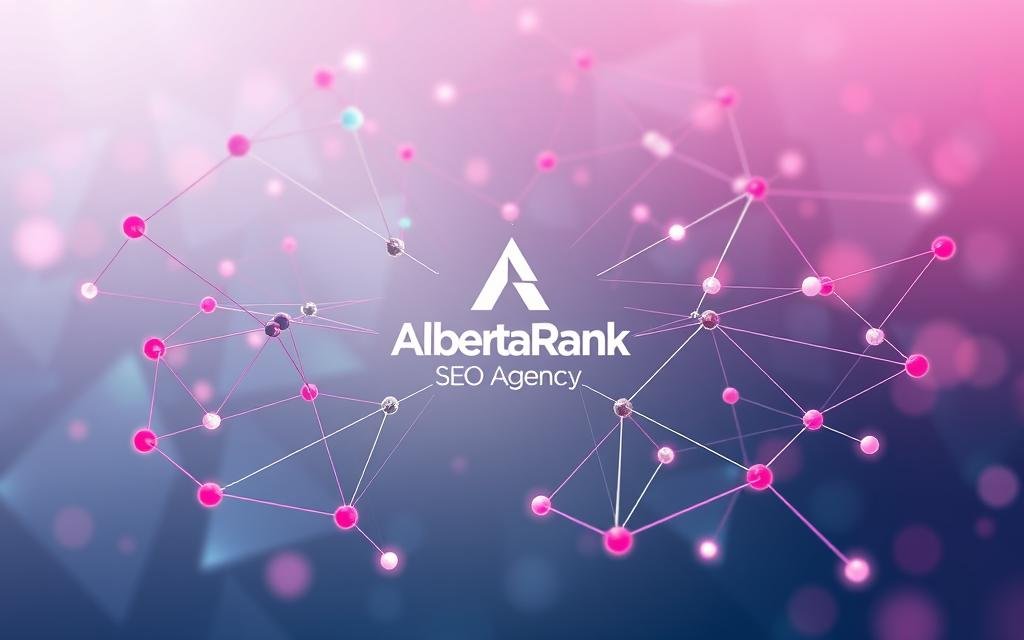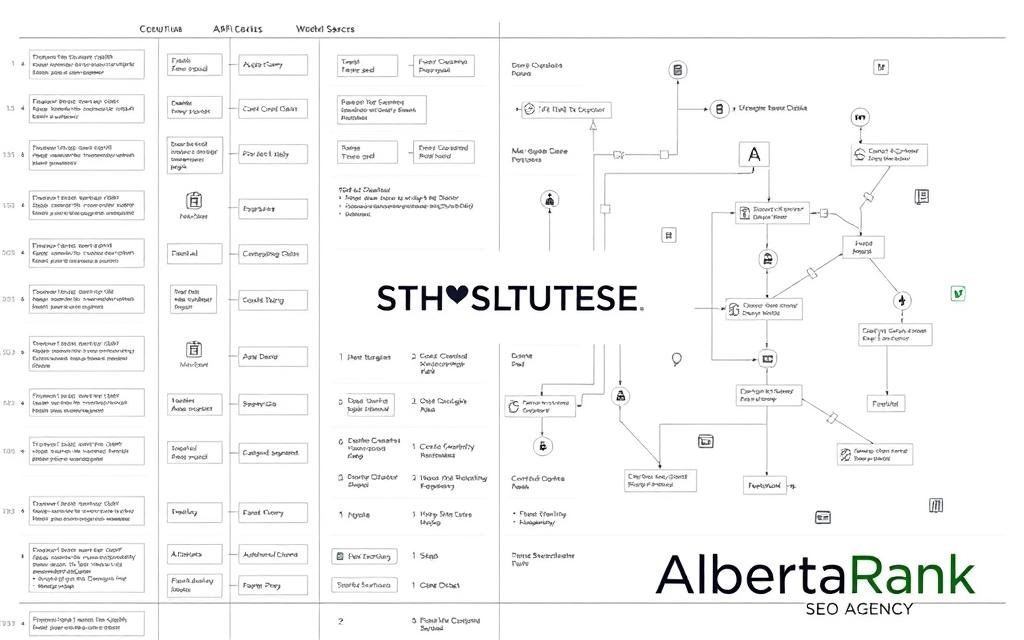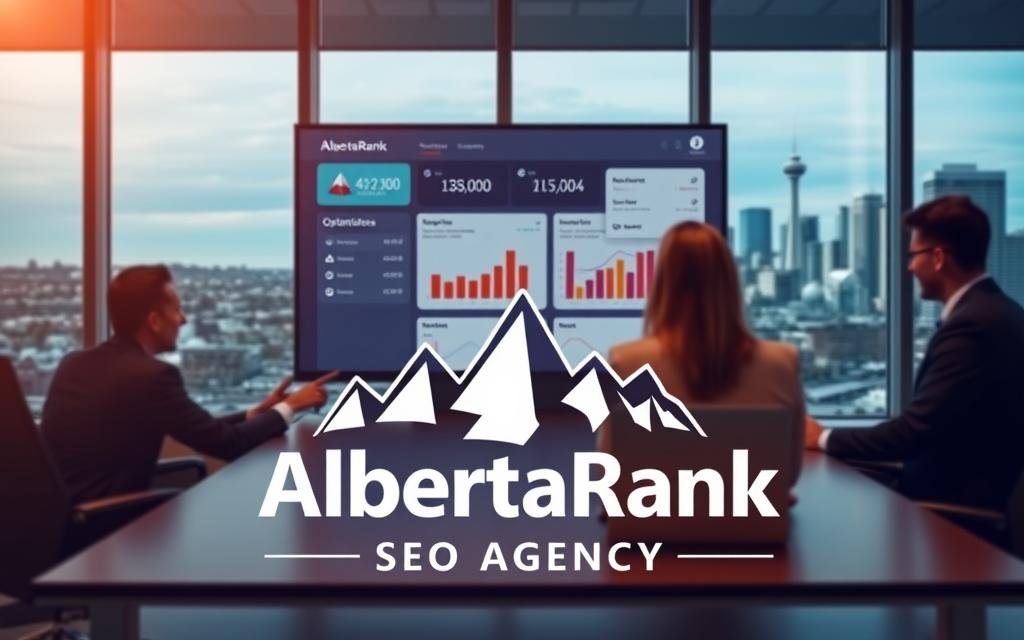Can a single page tweak send your Calgary or Edmonton website up the local search ladder? We ask that because small, smart changes often beat costly, blanket campaigns for Alberta SMBs.
At AlbertaRank.ca, we show how focused on-page seo and clear content meet local search intent. We use simple edits—title tags, headings, URLs and internal links—to make a page easier for people and AI to read.
Our approach pairs fast, mobile-friendly UX with LLM-friendly formatting so each page can surface in search and AI answers. You’ll see where to place keywords naturally and how a better title can lift click-throughs and help ranking momentum.
We aim for measurable outcomes: more local traffic, stronger website signals, and pages that earn calls and leads across Calgary, Edmonton and beyond.
Key Takeaways
- We focus on targeted, practical on-page seo that fits Alberta businesses.
- Small page edits can move rankings faster than broad campaigns.
- Titles and headings drive CTR and search visibility.
- Format content for users and AI to capture local queries.
- Speed and mobile readiness matter for Alberta search traffic.
Understand on-page SEO in the present landscape for Alberta businesses
Local search in Alberta now rewards clear page signals and fast wins. We focus on the elements you control on a page—titles, headings, URLs, internal links, images and schema—to lift relevance for Calgary and Edmonton searches.
What on-page seo covers versus off-page seo: on-page work shapes the content and metadata that search engines read. Off-page seo covers backlinks, social and digital PR you can’t fully control.
Small tweaks often beat slow, broad campaigns. Google still looks for matching keywords early in a page, and better titles and headings can improve CTR and ranking momentum.
“Page experience—HTTPS, mobile readiness and Core Web Vitals—are clear ranking signals you can fix at the site level.”
- Update title and first 100 words to mirror local search queries.
- Fix core web vitals and ensure HTTPS for trust and speed.
- Use clean internal links so search engines find priority pages.
| Focus | On-page seo | Off-page seo |
|---|---|---|
| Controls | Content, meta, headings, schema, URLs | Backlinks, mentions, PR, social signals |
| Speed to impact | Weeks to months with small edits | Months to years, less predictable |
| Best for | Local page relevance and AI visibility | Authority and broad domain trust |
We measure each page change so you can see real ranking and call-volume movement in Calgary and Edmonton.
Match search intent before you optimise a single page
Before you edit a single page, know exactly what searchers expect to find. We tailor intent‑matched content for Alberta audiences so you aren’t fighting the wrong battle or building the wrong page type.
Identify intent types
We classify queries as informational, commercial, transactional, or navigational. Each needs a different page format: how‑to blog posts, comparison pages, product/service pages, or simple directional pages.
Validate intent by scanning current SERPs
Check the first page of search results to see formats, featured snippets, People Also Ask, and zero‑click features. If results show tools like calculators or checkers, a blog posts page alone will struggle to rank.
“Aligning content format with intent prevents wasted effort and speeds results.”
- Map keywords to the right page type before you start writing.
- Use quick keyword research to confirm local demand in Calgary and Edmonton.
- Match your title and page format to what ranks—tools, FAQs, or product pages.
We use this checklist so your pages meet real search intent and drive the right traffic.
On-Page Optimization
Practical page fixes often deliver the fastest, measurable lifts for Calgary and Edmonton sites. We focus on clear, tracked changes — not bloated audits or vague recommendations.
Core on-page seo steps: place the target keyword in the title, H1, first 100–150 words, select H2/H3s, the URL and image alt text. Make sure each key page has a unique title and meta to avoid duplication and missed clicks.
We compress images, add schema, and create short, descriptive URLs. These moves help search and LLMs interpret your pages faster.
“Small, focused edits that are measured over time beat broad, unfocused work every time.”
What we track: internal links from strong site pages to priority offers, core web vitals, mobile readiness and before/after ranking and call volume. We document each change so you can see the impact.
- Follow clear formatting and concise copy so people and AI can summarise your page.
- Make sure links and schema clarify intent for rich results.
- Prioritise measurable edits that lift traffic and leads.
Plan topical coverage that AI and search engines reward
Build a topic map that connects a core idea to local questions and the related searches people actually use.

We start by mapping the core topic and pulling People Also Ask gaps that matter in Calgary and Edmonton. This step guides our keyword research and shows which subtopics your site must cover.
Map core topic, related concepts, and “People also ask” gaps
We list the main questions and group them into short sections: definition, steps, examples, and local context. Front‑loading answers helps users and AI get the quick facts they need.
Demonstrate EEAT with author creds, quotes, and real experience
We add author bios, real examples from Alberta projects, and expert quotes so pages earn trust and higher value in AI summaries.
“Clear local examples and author credits increase a page’s chance of being cited in AI answers.”
- Use targeted keyword research to find must‑cover subtopics.
- Create supporting blog posts that link back to the main page.
- Review the title and meta so the page communicates full coverage.
Craft titles and meta descriptions that earn the click
Good titles and meta descriptions turn searchers into callers in Calgary and Edmonton. We focus on concise, honest tags that match intent and boost CTR for pages that matter to your business.
Title best practices: length, front‑loaded keywords, modifiers, freshness
Keep titles ~50–60 characters and front-load the primary keyword when it reads naturally. Use modifiers like “best,” “2025,” or city names to improve relevance and long-tail reach.
Meta descriptions that expand on value and get bolded terms
Write meta descriptions under ~160 characters that include the keyword early so search results bold it. Expand on the page value—benefit, location and a call to action—to nudge clicks without exaggeration.
Prioritise unique tags on key pages that drive business
We prioritise services, location pages and top blog posts for unique title tags and meta descriptions so those pages can rank higher and convert more visitors.
“Clear, local-first titles and meta descriptions are a low-effort, high-impact way to lift CTR and rank higher in search.”
Place keywords where they matter most
Start each page by placing your primary keyword in the first 100–150 words so the topic is clear to both people and search engines. We write the opening lines to state the page purpose and local relevance quickly, helping Calgary and Edmonton users decide to stay.
First 100–150 words, H1, selective H2/H3, URL, and alt text
Put the target keyword in the H1 and the opening paragraph. Then reinforce it in one or two H2/H3 subheads and the concise URL slug. Add the same term to image alt attributes so assistive tech and crawlers see consistent signals.
Use natural frequency without keyword stuffing
We repeat keywords only when they add clarity. Avoid awkward phrasing or excess repeats that look like keyword stuffing. Natural placement across the title, early body, headings, and URL confirms topical focus without penalties.
- Intro placement: keyword inside first 100–150 words.
- Headings: align H1 and select H2/H3 with related keywords.
- URL: short slug with the main term.
- Images: alt text that matches the keyword context.
- Cluster: reuse related keywords across supporting pages.
| Placement | Why it matters | Best practice |
|---|---|---|
| H1 / Title | Signals primary topic to search and users | Front-load keyword; keep natural |
| First 100–150 words | Early weighting by search engines | State intent, include keyword once |
| URL slug | Reinforces page relevance and click clarity | Short, hyphenated, keyword-focused |
| Image alt | Accessibility and contextual signal | Describe image with keyword naturally |
We document every placement change so you can track impact on rankings and clicks.
Structure content for humans, LLMs, and passage ranking
Structure content so the answer appears first and is easy to quote. We make a clear takeaway up front, then add short, focused paragraphs that expand the idea.
Semantic chunking with descriptive subheads and quotable lines
Break the page into named sections so readers can scan and find facts fast. Each heading should describe what follows in plain text.
Write one or two crisp sentences per block that can be grabbed as a quote or used in a featured snippet.
Lead with the answer, then add supporting depth
Start sections with the direct answer, then list short steps, examples or proof. This helps readers and makes it easy for search engines to extract passages.
- Use mini-summaries for complex topics to signal intent quickly.
- Keep paragraphs short and active so the page reads well on mobile.
- Add structured data where it matches visible text to clarify meaning to AI.
“Lead with the conclusion, then give the detail—this improves findability and snippet potential.”
Build reader-first layout and UX signals
Readable layout turns visitors into callers. We design pages so Alberta users find answers fast and act with confidence.
Readable formatting: short paragraphs, whitespace, scannable headings
We break content into short paragraphs and clear headings to improve reading flow and on-screen comprehension. This simple formatting raises engagement on both desktop and mobile.
Short blocks of text and generous whitespace make complex topics approachable for busy Calgary and Edmonton readers.
Guide users to outcomes on both desktop and mobile
We place primary calls-to-action where thumbs reach first and keep navigation consistent across the site. That makes it easy for visitors to call, fill a form, or request a quote.
Google weighs page experience signals like Core Web Vitals, HTTPS and mobile-friendliness. We monitor engagement and refine layouts so your pages perform and can rank higher in local search.
- Consistent patterns across the site help users find key info quickly.
- Copy and design work together—text supports visuals and vice versa.
- We test changes and track impact on the most important pages.
Our goal: make sure your site gives a great user experience so Alberta visitors trust the page and contact you.
Optimise URLs for clarity and relevance
A readable URL helps Albertans decide whether a result is relevant before they click. We keep slugs short and descriptive so Calgary and Edmonton users instantly understand what the page is about.
Short, descriptive slugs using the target keyword
Use concise slugs that include the main keyword and describe the page clearly. A simple pattern like /keyword-research-guide or /plumbing-calgary makes the website look organised and trustworthy in search results.
Keep URLs aligned with your title and H1 so visitors feel confident they’ve clicked the right page.
Avoid dates and filler words; enable breadcrumb-friendly paths
Avoid years, stop words, and long folders that make urls hard to read. Clean paths often appear as breadcrumb trails in search results and boost click-throughs.
- Standardise folder structure so pages website hierarchies look logical.
- Document redirects from old urls to protect ranking equity.
- Use relevant keywords sparingly—clarity first, SEO second.
We document and monitor URL changes so any impact on discoverability is visible and reversible. Simple, readable URLs make your website easier to share and more likely to earn clicks from local searchers.
Internal linking that spreads authority intelligently
Smart internal linking turns scattered pages into a coordinated site that ranks together.
We build clear hub-and-spoke pillars so your strongest pages lift the ones that matter most for Alberta growth.
Internal links help crawlers find pages, understand relationships, and pass authority. We map topic hubs and connect supporting content so the site behaves like a network, not a pile of uncategorised posts.

Hub-and-spoke pillars to connect related topics
Each pillar page acts as the main hub. Supporting pages link up to it and across to sibling pages.
This structure focuses authority and makes it easy for users to follow the path from learning to contact.
Anchor text that’s relevant, varied, and natural
We write anchor text that describes the destination and avoids exact-match overload. Natural phrases help search and people understand context.
Prioritise links from high-authority pages to priority targets
Links from your most visited or most linked pages pass the most value. We place contextual links inside paragraphs where users click.
- Map hubs and add internal links so authority flows where it counts.
- Add links from high-traffic pages to priority offers.
- Use varied anchor text to signal relevance without over-optimising.
- Ensure no important page is orphaned; crawlers must reach every priority page.
We monitor and iterate monthly—measuring the effect on rankings and conversions and adjusting internal linking to match your sales journey.
Use external links to strengthen relevance and trust
Citing reputable sources strengthens your claims and helps search engines understand your topic.
We add links to authoritative references that support facts and make your page more trustworthy for Calgary and Edmonton readers.
Our team uses clear anchor text so users know what the next page delivers. We avoid low-quality sources to protect your site and keep signals clean for search.
We review external links regularly and fix or replace any that break. That prevents bad UX and preserves credibility over time.
- Prefer trusted Canadian and Alberta resources for local credibility.
- Balance outbound links so they support the offer without distracting readers.
- Ensure external links open without disrupting the conversion path.
“Outbound citations clarify context for readers and for search engines.”
We document a linking policy so editors follow best practices and so your site complements off-page seo efforts. We also track how select references affect engagement and time on page.
Image optimisation to win speed and image search
Reducing image weight and adding clear alt text makes your website more accessible and discoverable. We optimise images so Alberta visitors get fast, inclusive experiences on every page.
Compress assets and size responsibly
Compress images with reliable tools like ShortPixel or similar tools to cut file size without visible quality loss.
Size images to actual display dimensions so pages don’t send extra megabytes to mobile users.
Descriptive filenames and meaningful alt text
We use clear filenames that describe the image and the page context. Then we write accurate alt text so screen readers and search can understand the visual content.
Optimised images can rank in image search and appear in AI responses. Check for missing alt attributes and oversized files regularly.
| Action | Why it matters | Example |
|---|---|---|
| Compress with tools | Reduces load time and improves Core Web Vitals | ShortPixel, WebP conversion |
| Size to display | Avoids unnecessary bytes on mobile | Serve 800px for hero, 400px for thumbnails |
| Descriptive names & alt | Boosts accessibility and image search signals | calgary-plumber-truck.jpg + alt text: “plumbing truck in Calgary” |
- Remove decorative images from critical render paths.
- Adopt consistent naming and alt guidelines across pages.
- Monitor image-related Core Web Vitals and fix issues fast.
Technical on-page essentials that impact rankings
Technical issues under the hood often decide whether a page can actually rank, no matter how good the content is. We fix the foundations so your Alberta content can compete on merit, not be held back by technical gaps.
Core Web Vitals, HTTPS and mobile-first readiness
Page experience is a key ranking factor. We review Core Web Vitals using PageSpeed Insights and CrUX, then remove bottlenecks that slow critical elements.
We enforce HTTPS across every page to protect users and signal trust to search engines. Mobile-first indexing means we test and fix the mobile view first so the site renders correctly for Google’s crawler.
Clean crawlability: 200 OK, robots rules and orphan fixes
We confirm important urls return 200 OK and aren’t blocked by robots or meta directives. Redirect chains are shortened and titles or template changes are monitored so performance isn’t harmed by careless edits.
- Reconnect orphan pages with contextual links so crawlers and users find them.
- Evaluate hosting, caching and CDNs to improve speed and stability site-wide.
- Optimise images, scripts and fonts to boost user experience and retain traffic.
“Technical seo is the foundation that lets your pages show their value in search.”
We document fixes and measure how these technical improvements correlate with ranking gains and real business results in Calgary and Edmonton.
Schema markup that clarifies meaning to AI and Google
Well-formed structured data makes your Alberta expertise obvious to search systems. We add schema so AI and search engines read your content as factual and local.

Article, Organization, FAQPage and HowTo where appropriate
Choose the right type: use Article for guides, Organization for company info, FAQPage for Q&A, and HowTo for step lists.
Include author, publish date and clear title so EEAT signals align with the visible page content.
Align schema with visible content to avoid mismatches
Structured data must mirror what users see. Mismatched markup risks manual action and lost rich results.
“Both Google and Microsoft confirm structured data helps AI systems interpret content.”
- We map schema to the page purpose and include only truthful fields.
- Validate markup with tools and monitor rich result changes.
- Update structured data when content or keywords change.
- Scale with templates so every page follows the same pattern.
| Schema type | Best for | Key fields to include |
|---|---|---|
| Article | Guides and blog posts | headline, author, datePublished, image |
| Organization | Company pages and contact info | name, logo, sameAs, contactPoint |
| FAQPage / HowTo | Q&A and step-by-step pages | mainEntity, question, answer, step |
We validate and track how structured data affects impressions, clicks and engagement so Alberta pages keep improving in local search.
Localise your on-page SEO for Alberta searchers
Make your website speak Calgary and Edmonton by weaving place names into titles and headers.
We add local context so people and search systems see relevance fast. Use city and neighbourhood terms when intent is local. That helps your page appear for nearby search queries and lifts clicks from people who plan to act.
Include Alberta place terms and service areas in titles and headers
Put Calgary or Edmonton in the title and H1 when the page targets that area. Keep the phrasing natural and benefit-focused.
Example: “Emergency Furnace Repair — Calgary” or “Commercial Cleaning in Edmonton.”
Optimise for local intent pages and consistent NAP on every page
Standardise your NAP (name, address, phone) across every page and on your Google Business Profile. Consistency builds trust for customers and search platforms.
Build service-area pages for each city or neighbourhood you serve. Link those pages from relevant blog posts and service descriptions so Google maps locality across your website.
- Use place names in titles, H1s and opening lines to target local search.
- Keep NAP identical across pages and directory listings.
- Create short service-area pages that answer local questions.
- Connect local pages with internal links to show relationships.
| Action | Why it helps | How we do it |
|---|---|---|
| Place names in titles | Boosts relevance for local search | Short, city‑first titles with a clear offer |
| Consistent NAP | Builds trust and local authority | Standardised format on every page + GMB match |
| Service-area pages | Targets region-specific queries | FAQ, examples, local reviews and contact CTA |
| Internal linking | Signals locality across the website | Contextual links from blogs to service pages |
“Local signals help Albertans find and contact you faster — we make sure every page speaks to the right neighbourhood.”
Why AlbertaRank.ca is different for on-page success
We focus on clear, measurable on-page work that actually moves traffic for Alberta businesses. Our approach cuts the fluff and targets the small changes that create consistent gains for Calgary and Edmonton sites.

We make sure each priority page has a short plan: a tuned title, copy aligned to intent, internal links added, and UX tidied. These steps lift CTR and help search systems understand the page quickly.
Targeted, results-oriented optimisation without big-agency fluff
No bloated reports. We run focused edits that follow best practices and suit Alberta markets. That means quick wins on titles and snippets, cleaner URLs, schema where it matters, and fixes to Core Web Vitals.
Transparent, measurable growth for Alberta companies
We measure traffic and rankings movement page by page so you see what works. We use tools like audits and dashboards to find wins and track gains.
- Action-first: changes you can see in traffic and calls.
- Clear reporting: we show what shipped, why, and the impact.
- Custom fit: strategies shaped to your website and industry, not templates.
“Our team tunes titles and snippets to boost CTR, then traces that lift back to enquiries and leads.”
| Service | What we do | Immediate benefit |
|---|---|---|
| Title & snippet work | Tune title, meta, and SERP preview | Higher CTR and clearer search listing |
| Content & internal links | Align copy, add contextual links | Better page relevance and site flow |
| Technical fixes | Core Web Vitals, clean redirects, schema | Improved discoverability and page speed |
Get expert help: Contact AlbertaRank
Need hands-on help improving your website and priority pages website quickly? We review your site, identify the high-impact page changes, and deliver a clear plan you can act on fast.
Call us or visit:
AlbertaRank, Calgary, AB T3N 1J5 — 403 671 3278
Hours:
Monday to Friday, 9am-5pm
Follow us for tips:
Instagram, Facebook, TikTok, LinkedIn, YouTube, X
We’ll assess your most important page first so you see results quickly. Our team shares a clear scope and timeline, aligns KPIs—calls, forms, visibility—and sets a simple reporting cadence that fits your schedule.
We respond fast and keep communication straightforward—no jargon. We can also train your team to maintain on‑page standards across future content so gains last.
- Call us at 403 671 3278 or visit Calgary, AB T3N 1J5 to plan your next page improvements.
- We’re available Monday to Friday, 9am-5pm, to review your site and outline quick wins.
- Follow our updates on Instagram, Facebook, TikTok, LinkedIn, YouTube, and X for practical tips you can apply to your website.
- We’ll set a clear scope, timeline and KPIs so every page update supports growth.
| Service | What we do | Immediate result |
|---|---|---|
| Page review | Audit priority page for content, links and speed | Short list of quick wins |
| Plan & timeline | Scope, KPIs and reporting cadence | Clear expectations and dates |
| Training | Team coaching on page standards | Long-term site improvements |
| Ongoing support | Report reviews and iterative fixes | Measurable visibility and lead growth |
“Reach out today to start turning your pages into measurable results.”
Conclusion
Start with the pages that matter and let gains compound across your site. We prioritise quick, measurable edits so you see movement in local search and leads without long, costly campaigns.
We focus on tight titles, early keyword placement, clean URLs, internal links, schema and UX to make each page work for Calgary and Edmonton audiences. LLM‑friendly structure and clear answers raise the chance of AI citations. Meta descriptions still drive clicks even when they don’t directly affect ranking.
Keep iterating: update titles, grow content, refine layouts, and scale these on‑page seo best practices across more pages. When you’re ready, we’ll help turn those improvements into measurable traffic and business growth for your website.

